日耳曼语言学导论8. Textlinguistik
- 格式:ppt
- 大小:1.39 MB
- 文档页数:30
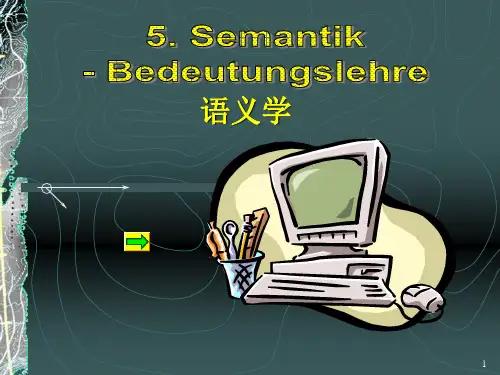
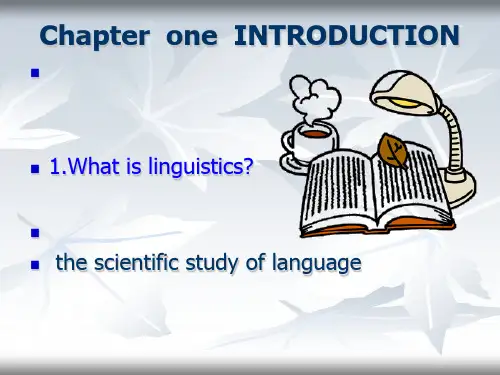
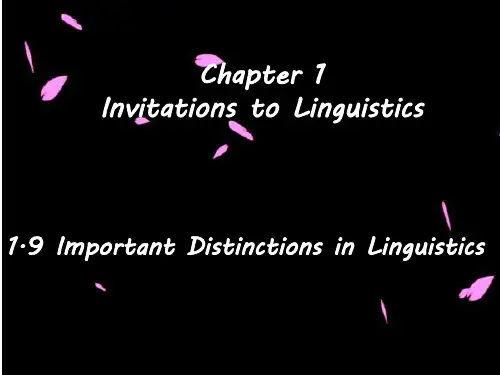
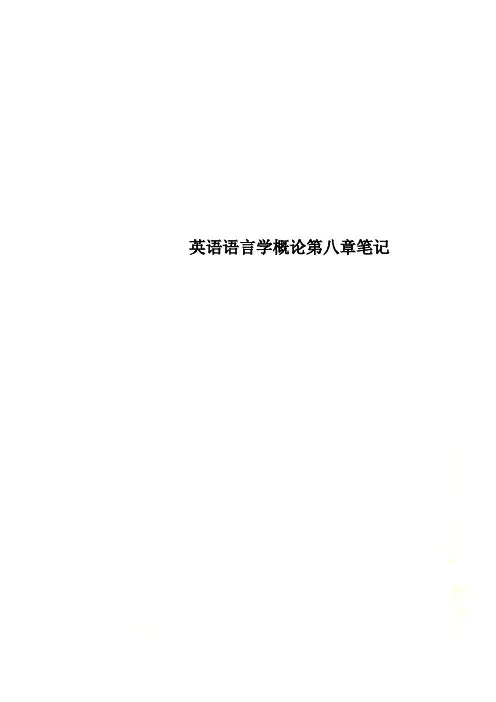
英语语言学概论第八章笔记Chapter 8 Socio-linguistics 社会语言学1.What is socio-linguistics? 什么是社会语言学?Sociolinguistics is the sub-discipline of linguistics that studies language in social contexts.社会语言学是语言学的一个分支,它研究社会环境中的语言。
nguage variation 语言变异a)S peech community 言语社区In sociolinguistic studies, speakers are treated as members of social groups. The social group isolated for any given study is called speech community. A speech community thus defined as a group of people who form a community (which may have as few members as a family or as many member as a country), and share the same language or a particular variety of language. The important characteristic of a speech community is that the members of the group must, in some reasonable way, interact linguistically with other members of the community. They may share closely related language varieties, as well as attitudes toward linguistic norms.社会语言学研究中,说话者被当作是社会群体的成员。
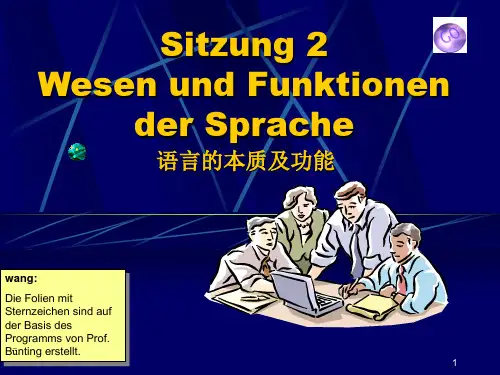
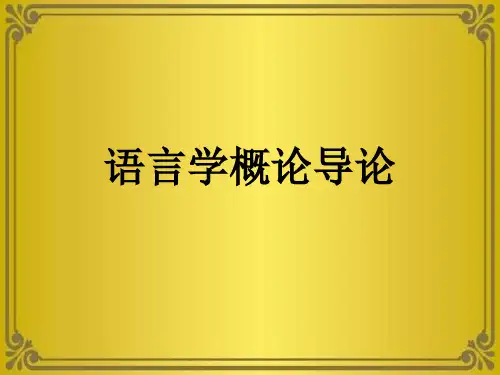
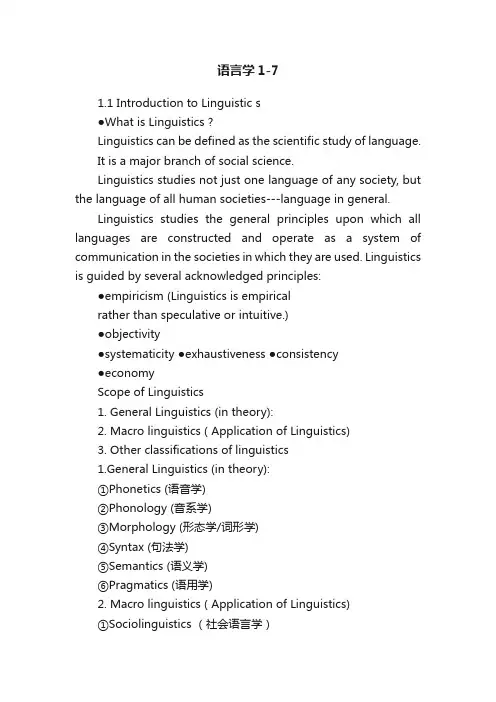
语言学1-71.1 Introduction to Linguistic s●What is Linguistics ?Linguistics can be defined as the scientific study of language.It is a major branch of social science.Linguistics studies not just one language of any society, but the language of all human societies---language in general.Linguistics studies the general principles upon which all languages are constructed and operate as a system of communication in the societies in which they are used. Linguistics is guided by several acknowledged principles:●empiricism (Linguistics is empiricalrather than speculative or intuitive.)●objectivity●systematicity ●exhaustiveness ●consistency●economyScope of Linguistics1. General Linguistics (in theory):2. Macro linguistics ( Application of Linguistics)3. Other classifications of linguistics1.General Linguistics (in theory):①Phonetics (语音学)②Phonology (音系学)③Morphology (形态学/词形学)④Syntax (句法学)⑤Semantics (语义学)⑥Pragmatics (语用学)2. Macro linguistics ( Application of Linguistics)①Sociolinguistics (社会语言学)②Psycholinguistics (心理语言学)③Corpus linguistics (语料库语言学)④Computational linguistics (计算语言学)⑤Stylistic linguistics (stylistics) (文体学/语体学)⑥Applied linguistics (应用语言学)⑦……3. Other Classifications of Linguistics (linguistic schools)①Functional linguistics (功能语言学)②Structural linguistics (结构语言学)③Chomskyan linguistics (乔姆斯基语言学)④Hallidayan linguistics(韩礼德语言学)⑤……History of Linguistics5th century BC, Ancient Greeks began to study languageAncient (Plato), word origin & word class of Greek15th century, universal grammar(Europe encountered other languages which forced scholars to look for a universal grammar.)18th century, the similarities of some languages(1786, Sir William Jones , the historical kinship of Sanskrit with Lain, Greek and the Germanic languages.)19th century, historical comparison of different languages early 20th century, modern linguistics(1916, F. de Saussure, Course in General linguistics)The historical development of linguistics●-Philology (语文学)( 5th cen BC—18th cen)●-Historical (comparative) linguistics (early 19th cen)●-Modern (synchronic)linguistics (1916---)(Course in General Linguistics, Ferdinand de. Saussure)F. de Saussure (1857-1913) 索绪尔Biography●1857年生于瑞士日内瓦的一个学者家庭。
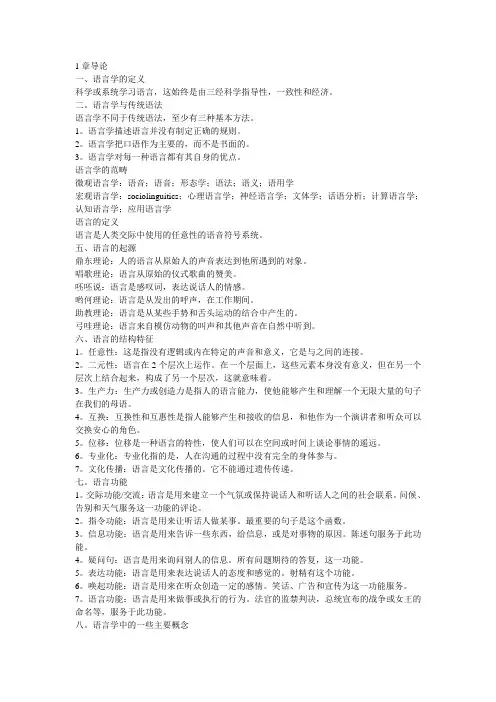
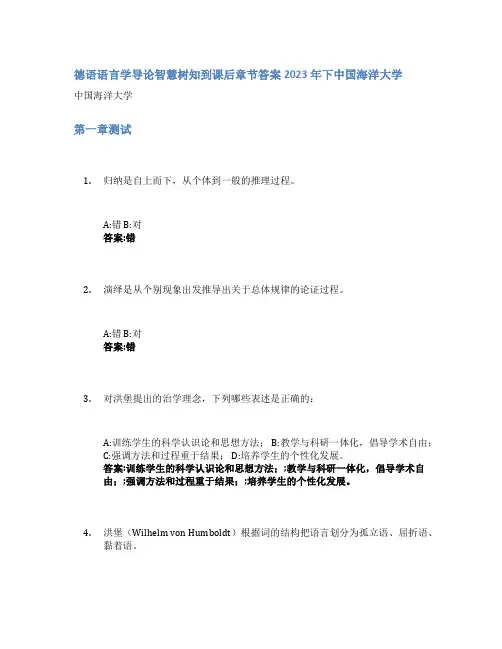
德语语言学导论智慧树知到课后章节答案2023年下中国海洋大学中国海洋大学第一章测试1.归纳是自上而下,从个体到一般的推理过程。
A:错 B:对答案:错2.演绎是从个别现象出发推导出关于总体规律的论证过程。
A:错 B:对答案:错3.对洪堡提出的治学理念,下列哪些表述是正确的:A:训练学生的科学认识论和思想方法; B:教学与科研一体化,倡导学术自由;C:强调方法和过程重于结果; D:培养学生的个性化发展。
答案:训练学生的科学认识论和思想方法;;教学与科研一体化,倡导学术自由;;强调方法和过程重于结果;;培养学生的个性化发展。
4.洪堡(Wilhelm von Humboldt)根据词的结构把语言划分为孤立语、屈折语、黏着语。
答案:对5.索绪尔的学说开辟了语言学的新纪元,下列哪些说法正确:A:语言有其结构体系,是一个有序的整体; B:区分了语言和言语二个不同的研究领域; C:语言是一个符号系统; D:语言学发展划分为三个阶段。
答案:语言有其结构体系,是一个有序的整体;;区分了语言和言语二个不同的研究领域;;语言是一个符号系统;6.乔姆斯基的理论使语言学从研究语言结构转向了语言的功能。
A:对 B:错答案:错7.Linguistik也称为Strukturalismus,即结构主义语言学。
A:对 B:错答案:对第二章测试1.动物的语言是先天的。
而人的言语能力是后天获得的。
答案:对2.与动物语言相比,人类语言具有以下特征:A:民族性 B:共同性 C:时代性 D:强制性答案:民族性;时代性;强制性3.下列表述错误的是:A:交际成功与否主要取决于对共同语言的熟悉程度。
B:语言交际的前提是双方使用共同的编码。
C:不同语言间的信息交流必须进行编码转换。
D:同一语言群体内的信息交流不按照约定俗成的语言规则,也能交际成功。
答案:同一语言群体内的信息交流不按照约定俗成的语言规则,也能交际成功。
4.语言交际中的附带信息,如发音、语调、音量等也会传达信息。
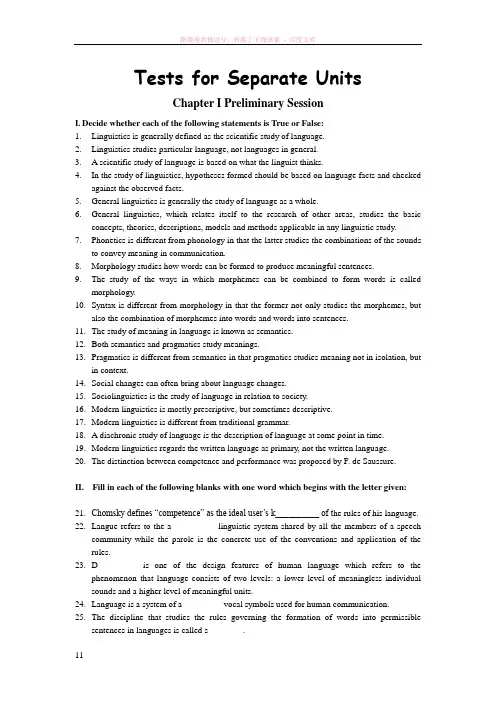
Tests for Separate UnitsChapter I Preliminary SessionI.Decide whether each of the following statements is True or False:1.Linguistics is generally defined as the scientific study of language.2.Linguistics studies particular language, not languages in general.3. A scientific study of language is based on what the linguist thinks.4.In the study of linguistics, hypotheses formed should be based on language facts and checkedagainst the observed facts.5.General linguistics is generally the study of language as a whole.6.General linguistics, which relates itself to the research of other areas, studies the basicconcepts, theories, descriptions, models and methods applicable in any linguistic study.7.Phonetics is different from phonology in that the latter studies the combinations of the soundsto convey meaning in communication.8.Morphology studies how words can be formed to produce meaningful sentences.9.The study of the ways in which morphemes can be combined to form words is calledmorphology.10.Syntax is different from morphology in that the former not only studies the morphemes, butalso the combination of morphemes into words and words into sentences.11.The study of meaning in language is known as semantics.12.Both semantics and pragmatics study meanings.13.Pragmatics is different from semantics in that pragmatics studies meaning not in isolation, butin context.14.Social changes can often bring about language changes.15.Sociolinguistics is the study of language in relation to society.16.Modern linguistics is mostly prescriptive, but sometimes descriptive.17.Modern linguistics is different from traditional grammar.18. A diachronic study of language is the description of language at some point in time.19.Modern linguistics regards the written language as primary, not the written language.20.The distinction between competence and performance was proposed by F. de Saussure.II.Fill in each of the following blanks with one word which begins with the letter given:21.Chomsky defines “competence” as the ideal user’s k__________ of t he rules of his language.ngue refers to the a__________ linguistic system shared by all the members of a speechcommunity while the parole is the concrete use of the conventions and application of the rules.23.D_________ is one of the design features of human language which refers to thephenomenon that language consists of two levels: a lower level of meaningless individual sounds and a higher level of meaningful units.nguage is a system of a_________ vocal symbols used for human communication.25.The discipline that studies the rules governing the formation of words into permissiblesentences in languages is called s________.26.Human capacity for language has a g ____ basis, but the details of language have to be taughtand learned.27.P ____ refers to the realization of langue in actual use.28.Findings in linguistic studies can often be applied to the settlement of some practicalproblems. The study of such applications is generally known as a________ linguistics.nguage is p___________ in that it makes possible the construction and interpretation ofnew signals by its users. In other words, they can produce and understand an infinitely large number of sentences which they have never heard before.30.Linguistics is generally defined as the s ____ study of language.III.There are four choices following each statement. Mark the choice that can best complete the statement.31.If a linguistic study describes and analyzes the language people actually use, it is said to be______________.A.prescriptiveB.analyticC.descriptiveD.linguistic32.Which of the following is not a design feature of human language?A.ArbitrarinessB.DisplacementC.DualityD.Meaningfulness33.Modern linguistics regards the written language as ____________.A.primaryB.correctC.secondaryD.stable34.In modern linguistics, speech is regarded as more basic than writing, because ___________.A.in linguistic evolution, speech is prior to writingB.speech plays a greater role than writing in terms of the amount of information conveyed.C.speech is always the way in which every native speaker acquires his mother tongueD.All of the above35. A historical study of language is a ____ study of language.A.synchronicB.diachronicC.prescriptiveparative36.Saussure took a (n)__________ view of language, while Chomsky looks at language from a________ point of view.A.sociological…psychologicalB.psychological…sociologicalC.applied… pragmaticD.semantic and linguistic37.37. According to F. de Saussure, ____ refers to the abstract linguistic system shared by all themembers of a speech community.A.paroleB.performancenguenguagenguage is said to be arbitrary because there is no logical connection between _________and meanings.A.senseB.soundsC.objectsD.ideas39.39. Language can be used to refer to contexts removed from the immediate situations of thespeaker. This feature is called_________,A.displacementB.dualityC.flexibilityD.cultural transmission40.The details of any language system are passed on from one generation to the next through____, rather than by instinct.A.learningB.teachingC.booksD.both A and BIV.Define the following terms:41.Linguistics42.Phonology43.Syntax44.Pragmatics45.Psycholinguisticsnguage47.Phonetics48.Morphology49.Semantics50.Sociolinguistics51.Applied Linguistics52.Arbitrariness53.Productivity54.Displacement55.Duality56.Design Featurespetence58.Performancengue60.ParoleV.Answer the following questions as comprehensively as possible. Give examples for illustration if necessary:nguage is generally defined as a system of arbitrary vocal symbols used for humancommunication. Explain it in detail.62.What are the design features of human language? Illustrate them with examples.63.How is modern linguistics different from traditional grammar?64.How do you understand the distinction between a synchronic study and a diachronic study?65.Why does modern linguistics regard the spoken form of language as primary, not the written?66.What are the major distinctions between langue and parole?67.How do you understand competence and performance?68.Saussure’s distinction between langue and parole seems similar to Chomsky’s distinctionbetween competence and performance. What do you think are their major differences?69.Do you think human language is entirely arbitrary? Why?Chapter 2 PhonologyI.Decide whether each of the following statements is True or False:1.Voicing is a phonological feature that distinguishes meaning in both Chinese and English.2.If two phonetically similar sounds occur in the same environments and they distinguishmeaning, they are said to be in complementary distribution.3. A phone is a phonetic unit that distinguishes meaning.4.English is a tone language while Chinese is not.5.In linguistic evolution, speech is prior to writing.6.In everyday communication, speech plays a greater role than writing in terms of the amountof information conveyed.7.Articulatory phonetics tries to describe the physical properties of the stream of soundswhich a speaker issues with the help of a machine called spectrograph.8.The articulatory apparatus of a human being are contained in three important areas: thethroat, the mouth and the chest.9.Vibration of the vocal cords results in a quality of speech sounds called voicing.10.English consonants can be classified in terms of place of articulation and the part of thetongue that is raised the highest.11.According to the manner of articulation, some of the types into which the consonants canbe classified are stops, fricatives, bilabial and alveolar.12.Vowel sounds can be differentiated by a number of factors: the position of tongue in themouth, the openness of the mouth, the shape of the lips, and the length of the vowels.13.According to the shape of the lips, vowels can be classified into close vowels, semi-closevowels, semi-open vowels and open vowels.14.Any sound produced by a human being is a phoneme.15.Phones are the sounds that can distinguish meaning.16.Phonology is concerned with how the sounds can be classified into different categories.17.A basic way to determine the phonemes of a language is to see if substituting one sound forother results in a change of meaning.18.When two different forms are identical in every way except for one sound segment whichoccurs in the same place in the strings, the two words are said to form a phonemic contrast.19.The rules governing the phonological patterning are language specific.20.Distinctive features of sound segments can be found running over a sequence of two ormore phonemic segments.II.Fill in each of the following blanks with one word which begins with the letter given:21. A ____ refers to a strong puff of air stream in the production of speech sounds.22.A___________ phonetics describes the way our speech organs work to produce thespeech sounds and how they differ.23.The four sounds /p/, /b/, /m/ and /w/ have one feature in common, i.e, they are allb_______ sounds.24.Of all the speech organs, the t ____ is the most flexible, and is responsible for varieties ofarticulation than any other.25.English consonants can be classified in terms of manner of articulation or in terms ofp_______ of articulation.26.When the obstruction created by the speech organs is total or complete, the speech soundproduced with the obstruction audibly released and the air passing out again is called a s________.27.S_________ features are the phonemic features that occur above the level of the segments.They include stress, tone, intonation, etc.28.The rules that govern the combination of sounds in a particular language are called s ____rules.29.The transcription of speech sounds with letter-symbols only is called broad transcriptionwhile the transcription with letter-symbols together with the diacritics is called n_________ transcription.30.When pitch, stress and sound length are tied to the sentence rather than the word inisolation, they are collectively known as i_________.31.P___________ is a discipline which studies the system of sounds of a particular languageand how sounds are combined into meaningful units to effect linguistic communication.32.The articulatory apparatus of a human being are contained in three important cavities: thepharyngeal cavity, the o_______ cavity and the nasal cavity.33.T_______ are pitch variations, which are caused by the differing rates of vibration of thevocal cords and which can distinguish meaning just like phonemes.34.Depending on the context in which stress is considered, there are two kinds of stress: wordstress and s_________ stress.III.There are four choices following each of the statements below. Mark the choice that can best complete the statement:35.Of all the speech organs, the _______ is/ are the most flexible.A. mouthB. lipsC. tongueD. vocal cords36.The sounds produced without the vocal cords vibrating are ____ sounds.A. voicelessB. voicedC. vowelD. consonantal37.__________ is a voiced alveolar stop.A. /z/B. /d/C. /k/D. /b/38.The assimilation rule assimilates one sound to another by “copying”a feature of asequential phoneme, thus making the two phones ____________.A. identicalB. sameC. exactly alikeD. similar39.Since /p/ and /b/ are phonetically similar, occur in the same environments and they candistinguish meaning, they are said to be ___________.A. in phonemic contrastB. in complementary distributionC. the allophonesD. minimal pair40.The sound /f/ is _________________.A. voiced palatal affricateB. voiced alveolar stopC. voiceless velar fricativeD. voiceless labiodental fricative41. A ____ vowel is one that is produced with the front part of the tongue maintaining thehighest position.A. backB. centralC. frontD. middle42.Distinctive features can be found running over a sequence of two or more phonemicsegments. The phonemic features that occur above the level of the segments are called ____________.A. phonetic componentsB. immediate constituentsC. suprasegmental featuresD. semantic features43. A (n) ___________ is a unit that is of distinctive value. It is an abstract unit, a collectionof distinctive phonetic features.A. phoneB. soundC. allophoneD. phoneme44.The different phones which can represent a phoneme in different phonetic environmentsare called the ____ of that phoneme.A. phonesB. soundsC. phonemesD. allophones <![endif]>IV.Define the terms below:45.phonology46.phoneme47.allophone48.international phonetic alphabet49.intonation50.phonetics51.auditory phonetics52.acoustic phonetics53.phone54.phonemic contrast55.tone56.minimal pairV.Answer the following questions as comprehensively as possible. Give ex¬amples for illustration if necessary:57.Of the two media of language, why do you think speech is more basic than writing?58.What are the criteria that a linguist uses in classifying vowels?59.What are the major differences between phonology and phonetics?60.Illustrate with examples how suprasegmental features can affect meaning.61.In what way can we determine whether a phone is a phoneme or not?Chapter 3 MorphologyI.Decide whether each of the following statements is True or False:1.Morphology studies the internal structure of words and the rules by which words are formed.2.Words are the smallest meaningful units of language.3.Just as a phoneme is the basic unit in the study of phonology, so is a morpheme the basic unitin the study of morphology.4.The smallest meaningful units that can be used freely all by themselves are free morphemes.5.Bound morphemes include two types: roots and affixes.6.Inflectional morphemes manifest various grammatical relations or grammatical categoriessuch as number, tense, degree, and case.7.The existing form to which a derivational affix can be added is called a stem, which can be abound root, a free morpheme, or a derived form itself.8.Prefixes usually modify the part of speech of the original word, not the meaning of it.9.There are rules that govern which affix can be added to what type of stem to form a newword. Therefore, words formed according to the morphological rules are acceptable words. 10.Phonetically, the stress of a compound always falls on the first element, while the secondelement receives secondary stress.II.Fill in each blank below with one word which begins with the letter given:11.M ____ is the smallest meaningful unit of language.12.The affix “-ish” in the word boyish conveys a g____ meaning.13.B___________ morphemes are those that cannot be used independently but have to becombined with other morphemes, either free or bound, to form a word.14.Affixes are of two types: inflectional affixes and d__________ affixes.15.D________ affixes are added to an existing form to create words.16.A s______ is added to the end of stems to modify the meaning of the original word and itmay case change its part of speech.17.C__________ is the combination of two or sometimes more than two words to create newwords.18.The rules that govern which affix can be added to what type of stem to form a new word arecalled m___________ rules.19.In terms of morphemic analysis, d_______________ can be viewed as the addition of affixesto stems to form new words.20. A s______ can be a bound root, a free morpheme, or a derived form itself to which aderivational affix can be added.III.There are four choices following each statement. Mark the choice that can best complete the statement:21.The morpheme “vision” in the common word “television” is a(n) ______.A. bound morphemeB. bound formC. inflectional morphemeD. free morpheme22.The compound word “bookstore” is the place where books are sold. This indicates that themeaning of a compound __________.A. is the sum total of the meaning of its componentsB. can always be worked out by looking at the meanings of morphemesC. is the same as the meaning of a free phrase.D. None of the above.23.The part of speech of the compounds is generally determined by the part of speech of__________.A. the first elementB. the second elementC. either the first or the second elementD. both the first and the second elements24._______ are those that cannot be used independently but have to be combined with othermorphemes, either free or bound, to form a word.A. Free morphemesB. Bound morphemesC. Bound wordsD. Words25._________ is a branch of grammar which studies the internal structure of words and therules by which words are formed.A. SyntaxB. GrammarC. MorphologyD. Morpheme26.The meaning carried by the inflectional morpheme is _______.A. lexicalB. morphemicC. grammaticalD. semantic27.Bound morphemes are those that ___________.A. have to be used independentlyB. can not be combined with other morphemesC. can either be free or boundD. have to be combined with other morphemes.28.____ modify the meaning of the stem, but usually do not change the part of speech of theoriginal word.A. PrefixesB. SuffixesC. RootsD. Affixes29._________ are often thought to be the smallest meaningful units of language by thelinguists.A. WordsB. MorphemesC. PhonemesD. Sentences30.“-s” in the word “books” is _______.A. a derivative affixB. a stemC. an inflectional affixD. a rootIV.Define the following terms31.morphology32.inflectional morphology33.derivational morphology34.morpheme35.free morpheme36.bound morpheme37.root38.affix39.prefix40.suffix41.derivationpoundingV.Answer the following questions:43.What are the main features of the English compounds?44.Discuss the types of morphemes with examples.Chapter 4 SyntaxI.Decide whether each of the following statements is True or False:1.Syntax is a sub-field of linguistics that studies the sentence structure of language,including the combination of morphemes into words.2.Grammatical sentences are formed following a set of syntactic rules.3.Sentences are composed of sequence of words arranged in a simple linear order, with oneadding onto another following a simple arithmetic logic.4.Universally found in the grammars of all human languages, syntactic rules that comprisethe system of internalized linguistic knowledge of a language speaker are known as linguistic competence.5.The syntactic rules of any language are finite in number, but there is no limit to thenumber of sentences native speakers of that language are able to produce and comprehend.6.In a complex sentence, the two clauses hold unequal status, one subordinating the other.7.Constituents that can be substituted for one another without loss of grammaticalitybelong to the same syntactic category.8.Minor lexical categories are open because these categories are not fixed and newmembers are allowed for.9.In English syntactic analysis, four phrasal categories are commonly recognized anddiscussed, namely, noun phrase, verb phrase, infinitive phrase, and auxiliary phrase.10.In English the subject usually precedes the verb and the direct object usually follows theverb.11.What is actually internalized in the mind of a native speaker is a complete list of wordsand phrases rather than grammatical knowledge.12. A noun phrase must contain a noun, but other elements are optional.13.It is believed that phrase structure rules, with the insertion of the lexicon, generatesentences at the level of D-structure.14.WH-movement is obligatory in English which changes a sentence from affirmative tointerrogative.II.Fill in each of the following blanks with one word which begins with the letter given:15. A s________ sentence consists of a single clause which contains a sub¬ject and apredicate and stands alone as its own sentence.16. A s______ is a structurally independent unit that usually comprises a number of words toform a complete statement, question or command.17. A s______ may be a noun or a noun phrase in a sentence that usually precedes thepredicate.18.The part of a sentence which comprises a finite verb or a verb phrase and which sayssomething about the subject is grammatically called p_________.19. A c_________ sentence contains two, or more, clauses, one of which is incorporated intothe other.20.In the complex sentence, the incorporated or subordinate clause is normally called ane_______ clause.21.Major lexical categories are o___ categories in the sense that new words are constantlyadded.22. A _____ Condition on case assignment states that a case assignor and a case recipientshould stay adjacent to each other.23.P_______ are syntactic options of UG that allow general principles to operate in one wayor another and contribute to significant linguistic variations between and among natural languages.24.The theory of C_____ condition explains the fact that noun phrases appear only insubject and object positions.III.There are four given choices for each statement below. Mark the choice that can best complete the statement:25. A sentence is considered ____ when it does not conform to the grammatical knowledgein the mind of native speakers.A. rightB. wrongC. grammaticalD. ungrammatical26. A __________ in the embedded clause refers to the introductory word that introduces theembedded clause.A. coordinatorB. particleC. prepositionD. subordinator27.Phrase structure rules have ____ properties.A. recursiveB. grammaticalC. socialD. functional28.Phrase structure rules allow us to better understand _____________.A.how words and phrases form sentencesB.what constitutes the grammaticality of strings of wordsC.how people produce and recognize possible sentencesD.All of the above.29.Syntactic movement is dictated by rules traditionally called ________.A.transformational rulesB.generative rulesC.phrase structure rulesD.x-bar theory30.The theory of case condition accounts for the fact that __________.A.noun phrases appear only in subject and object positions.B.noun phrases can be used to modify another noun phraseC.noun phrase can be used in adverbial positionsD.noun phrase can be moved to any place if necessary.31.The sentence structure is ________.A.only linearB.Only hierarchicalplexD.both linear and hierarchical32.The syntactic rules of any language are ____ in number.rgeB. smallC. finiteD. infinite33.The ________ rules are the rules that group words and phrases to form grammaticalsentences.A.lexicalB.morphologicalC.linguisticbinational34._______ rules may change the syntactic representation of a sentence.A.GenerativeB.TransformationalC.X-barD.Phrase structureIV.Define the following terms:35.syntax36.Sentence37.coordinate sentence38.syntactic categories39.grammatical relations40.linguistic competence41.transformational rules42.D-structureV.Answer the following questions:43.What are the basic components of a sentence?44.What are the major types of sentences? Illustrate them with examples.45.Are the elements in a sentence linearly structured? Why?46.What are the advantages of using tree diagrams in the analysis of sentence structures?47.What is NP movement? Illustrate it with examples.Chapter 5 SemanticsI.Decide whether each of the following statements is True or False:1.Dialectal synonyms can often be found in different regional dialects such as BritishEnglish and American English but cannot be found within the variety itself, for example, within British English or American English.2.Sense is concerned with the relationship between the linguistic element and thenon-linguistic world of experience, while the reference deals with the inherent meaning of the linguistic form.3.Linguistic forms having the same sense may have different references in differentsituations.4.In semantics, meaning of language is considered as the intrinsic and inherent relation tothe physical world of experience.5.Contextualism is based on the presumption that one can derive meaning from or reducemeaning to observable contexts.6.Behaviourists attempted to define the meaning of a language form as the situation inwhich the speaker utters it and the response it calls forth in the hearer.7.The meaning of a sentence is the sum total of the meanings of all its components.8.Most languages have sets of lexical items similar in meaning but ranked differentlyaccording to their degree of formality.9.“it is hot.” is a no-place predication because it contains no argument.10.In grammatical analysis, the sentence is taken to be the basic unit, but in semanticanalysis of a sentence, the basic unit is predication, which is the abstraction of the meaning of a sentence.II.Fill in each of the following blanks with one word which begins with the letter given:11.S________ can be defined as the study of meaning.12.The conceptualist view holds that there is no d______ link between a linguistic form andwhat it refers to.13.R______ means what a linguistic form refers to in the real, physical world; it deals withthe relationship between the linguistic element and the non-linguistic world of experience.14.Words that are close in meaning are called s________.15.When two words are identical in sound, but different in spelling and meaning, they arecalled h__________.16.R_________ opposites are pairs of words that exhibit the reversal of a relationshipbetween the two items.17.C ____ analysis is based upon the belief that the meaning of a word can be divided intomeaning components.18.Whether a sentence is semantically meaningful is governed by rules called s________restrictions, which are constraints on what lexical items can go with what others.19.An a________ is a logical participant in a predication, largely identical with the nominalelement(s) in a sentence.20.According to the n ____ theory of meaning, the words in a language are taken to be labelsof the objects they stand for.III.There are four choices following each statement. Mark the choice that can best complete the statement:21.The naming theory is advanced by ________.A.PlatoB.BloomfieldC.Geoffrey LeechD.Firth22.“We shall know a word by the company it keeps.” This statement represents _______.A.the conceptualist viewB.contexutalismC.the naming theoryD.behaviourism23.Which of the following is not true?A.Sense is concerned with the inherent meaning of the linguistic form.B.Sense is the collection of all the features of the linguistic form.C.Sense is abstract and de-contextualized.D.Sense is the aspect of meaning dictionary compilers are not interested in.24.“Can I borrow your bike?” _______ “ You have a bike.”A.is synonymous withB.is inconsistent withC.entailsD.presupposes25.25. ___________ is a way in which the meaning of a word can be dissected into meaningcomponents, called semantic features.A.Predication analysisponential analysisC.Phonemic analysisD.Grammatical analysis26.“alive” and “dead” are ______________.A.gradable antonymsB.relational oppositesplementary antonymsD.None of the above27._________ deals with the relationship between the linguistic element and thenon-linguistic world of experience.A.ReferenceB.ConceptC.SemanticsD.Sense28.___________ refers to the phenomenon that words having different meanings have thesame form.A.PolysemyB.SynonymyC.Homonymy。
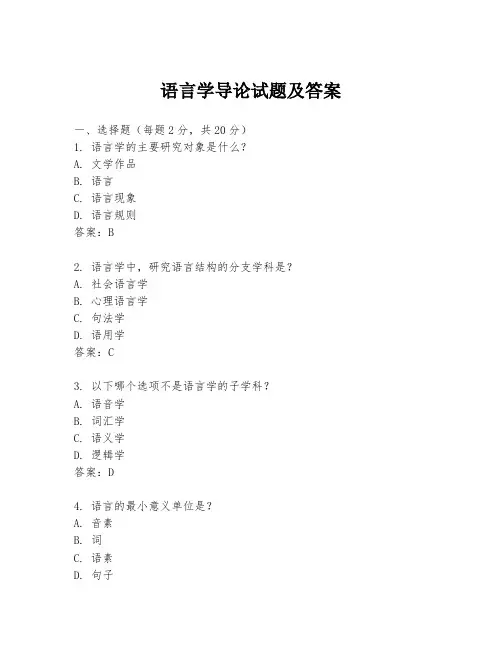
语言学导论试题及答案一、选择题(每题2分,共20分)1. 语言学的主要研究对象是什么?A. 文学作品B. 语言C. 语言现象D. 语言规则答案:B2. 语言学中,研究语言结构的分支学科是?A. 社会语言学B. 心理语言学C. 句法学D. 语用学答案:C3. 以下哪个选项不是语言学的子学科?A. 语音学B. 词汇学C. 语义学D. 逻辑学答案:D4. 语言的最小意义单位是?A. 音素B. 词C. 语素D. 句子答案:C5. 以下哪个术语是描述单词在特定语境中的意义?A. 语法意义B. 词义C. 语义D. 语用意义答案:D6. 语言的音素和字母之间的关系是?A. 一一对应B. 多对一C. 一对多D. 没有固定关系答案:D7. 以下哪个选项是描述语言随时间演变的学科?A. 社会语言学B. 历史语言学C. 心理语言学D. 神经语言学答案:B8. 语言的地域变体被称为?A. 语种B. 方言C. 语言D. 语言变体答案:B9. 以下哪个术语是描述语言的交际功能?A. 语言能力B. 语言表现C. 语言使用D. 语言结构答案:C10. 语言学中,研究语言在社会中的作用和影响的学科是?A. 社会语言学B. 心理语言学C. 神经语言学D. 历史语言学答案:A二、填空题(每题2分,共20分)1. 语言学的创始人是________。
答案:费迪南德·德·索绪尔2. 语言的四个基本功能包括表达、信息、社交和________。
答案:情感3. 语言的________性是指它能够传递新信息。
答案:创造性4. 语言的________性是指它能够传递旧信息。
答案:习惯性5. 语言学中,研究语言和思维关系的学科是________。
答案:心理语言学6. 语言的________性是指它能够跨越时间和空间进行交流。
答案:传递性7. 语言的________性是指它能够表达复杂的概念。
答案:表达性8. 语言学中,研究语言在大脑中如何被处理的学科是________。
TEM-8 语言学知识复习总结重要概念梳理第一节语言的本质一、语言的普遍特征(Design Features)1.任意性Arbitrariness:shu 和Tree都能表示“树”这一概念;同样的声音,各国不同的表达方式2.双层结构Duality:语言由声音结构和意义结构组成(the structure of sounds and meaning)3.多产性productive:语言可以理解并创造无限数量的新句子,是由双层结构造成的结果(Understand andcreate unlimited number with sentences)4.移位性Displacement:可以表达许多不在场的东西,如过去的经历、将来可能发生的事情,或者表达根本不存在的东西等5.文化传播性Cultural Transmission:语言需要后天在特定文化环境中掌握6.Interchangeability可交换性7.Reflexivity 自反性二、语言的功能(Functions of Language)1.传达信息功能Informative:最主要功能The mainfunction2.人际功能Interpersonal:人类在社会中建立并维持各自地位的功能establish and maintain their identity 3.行事功能performative:现实应用——判刑、咒语、为船命名等Judge,naming,and curses4.情感功能Emotive:表达强烈情感的语言,如感叹词/句exclamatory expressions5.寒暄功能Phatic:应酬话phatic language,比如“吃了没?”“天儿真好啊!” 等等6.元语言功能Meta-lingual:用语言来谈论、改变语言本身,如book可以指现实中的书也可以用“book这个词来表达作为语言单位的“书”三、语言学的分支1. 核心语言学Core linguisticl 语音学Phonetics:关注语音的产生、传播和接受过程,着重考察人类语言中的单音。